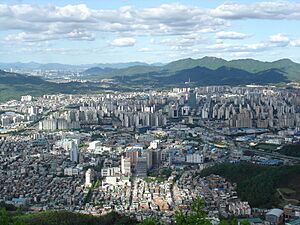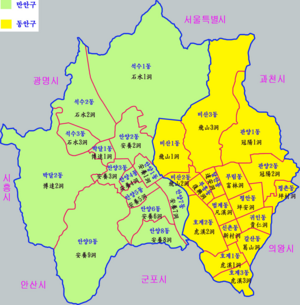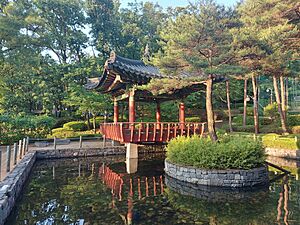Anyang, Gyeonggi facts for kids
Quick facts for kids
Anyang
안양시
|
|||
|---|---|---|---|
| Korean transcription(s) | |||
| • Hangul | 안양시 | ||
| • Hanja | 安養市 | ||
| • Revised Romanization | Anyang-si | ||
| • McCune–Reischauer | Anyang-si | ||

Anyang city from Suri mountain.
|
|||
|
|||

Location in South Korea
|
|||
| Country | |||
| Region | Gyeonggi Province (Sudogwon) | ||
| First mention | 415 | ||
| City status | 1967 | ||
| Administrative divisions | 2 gu (Manan Gu & Dongan Gu), 31 dong | ||
| Area | |||
| • Total | 58.46 km2 (22.57 sq mi) | ||
| Elevation | 47 m (154 ft) | ||
| Population
(31 October 2016)
|
|||
| • Total | 595,644 | ||
| • Density | 10,188.92/km2 (26,389.2/sq mi) | ||
| • Dialect | Seoul | ||
| • Households | 224,501 | ||
| Postal code |
13900 to 14199
|
||
| Area code(s) | (+82) 31 | ||
Anyang is a lively city in Gyeonggi Province, South Korea. It's home to about 600,000 people, making it one of the largest cities in the country. Anyang is like a close neighbor to Seoul, located just 21 kilometers south. It's also easy to reach Seoul using the Seoul Subway Line 1 and Line 4. Anyang's motto is "Livable city, Proud citizens," showing how much people enjoy living there. The city's symbols include a grape mascot named 'Podong-i', the beautiful Forsythia flower, the Ginkgo tree, and strong eagles.
Contents
Exploring Anyang's Landscape and Climate
Anyang is split into two main parts for managing the city: the Manan district in the west and the Dongan district in the east. The Manan district is the older, original downtown area. It has a busy shopping area with outdoor markets. The Dongan district is a newer, more modern area. The tallest building in Anyang is the Acro Tower, a twin office building. Anyang is a great place for travel, connecting Seoul to other big cities.
Anyang covers an area of 58.46 square kilometers. A large part of the city is covered by forests and fields. Anyang is surrounded by mountains on all sides. These include Gwanak Mountain and Samsung Mountain to the north. Suri Mountain is to the southwest, and Cheongye Mountain and Morak Mountain are on other sides. Eight streams and rivers flow through Anyang, stretching for 34 kilometers.
The main river is the Anyang River. It is one of the four main rivers that flow into the Han River in Seoul. The Anyang River is 32.2 kilometers long. It flows through the center of Anyang city. Many people enjoy walking, jogging, or riding bikes along the river. The river flows through seven cities in Gyeonggi Province. This has sometimes caused issues with pollution. To help, the Anyang Stream Watershed Management Committee works to improve water quality. A factory site that once caused pollution was later turned into a city park in 2008.
Anyang's Weather Patterns
Anyang has a climate with cold, dry winters and hot, humid summers. It is usually a bit cooler than Seoul in the summer. The average temperature each year is 12.3 degrees Celsius. The city gets about 1,344 millimeters of rain annually. Most of Anyang's rain falls during the monsoon season. This rainy period happens between June and August.
| Climate data for Anyang (2004–2020 normals) | |||||||||||||
|---|---|---|---|---|---|---|---|---|---|---|---|---|---|
| Month | Jan | Feb | Mar | Apr | May | Jun | Jul | Aug | Sep | Oct | Nov | Dec | Year |
| Mean daily maximum °C (°F) | 2.3 (36.1) |
5.2 (41.4) |
10.8 (51.4) |
17.3 (63.1) |
23.4 (74.1) |
27.4 (81.3) |
28.8 (83.8) |
30.2 (86.4) |
25.9 (78.6) |
20.1 (68.2) |
11.9 (53.4) |
4.0 (39.2) |
17.3 (63.1) |
| Daily mean °C (°F) | −1.4 (29.5) |
1.1 (34.0) |
6.3 (43.3) |
12.3 (54.1) |
18.4 (65.1) |
22.9 (73.2) |
25.4 (77.7) |
26.4 (79.5) |
21.8 (71.2) |
15.5 (59.9) |
8.0 (46.4) |
0.4 (32.7) |
13.1 (55.6) |
| Mean daily minimum °C (°F) | −4.8 (23.4) |
−2.5 (27.5) |
2.4 (36.3) |
8.1 (46.6) |
13.9 (57.0) |
19.0 (66.2) |
22.5 (72.5) |
23.5 (74.3) |
18.2 (64.8) |
11.5 (52.7) |
4.2 (39.6) |
−3.1 (26.4) |
9.4 (48.9) |
| Average precipitation mm (inches) | 12.6 (0.50) |
27.1 (1.07) |
36.5 (1.44) |
69.1 (2.72) |
92.7 (3.65) |
114.1 (4.49) |
409.9 (16.14) |
257.3 (10.13) |
144.5 (5.69) |
50.7 (2.00) |
58.3 (2.30) |
22.1 (0.87) |
1,294.9 (50.98) |
| Average precipitation days (≥ 0.1 mm) | 3.2 | 3.5 | 5.4 | 7.5 | 7.4 | 8.1 | 14.3 | 12.1 | 8.2 | 4.6 | 7.0 | 5.5 | 86.8 |
| Source: Korea Meteorological Administration | |||||||||||||
Anyang's Past and Growth
The name Anyang comes from Anyang mall, built by Wang Geon. He was the first Emperor of the Goryeo dynasty. In the year 900, Wang Geon was a general. He was passing through Samsung Mountain when he met an old Buddhist priest. Wang Geon decided to build a temple there. The word "Anyang" itself is a Buddhist term. It means a heavenly place filled with great joy and freedom.
Like many cities in South Korea, Anyang has grown a lot in recent years. After the Korean War, Anyang was mostly farms. It was famous for growing grapes. Anyang officially became a city in 1973. Since then, it has become one of the most populated cities in the country. Many people who work in Seoul now live in Anyang. This is because it is so close to Seoul.
Key Moments in Anyang's Recent History
- 1973: Anyang officially becomes a city.
- 1977: A big flood affects the Seoul area. Anyang Technical College opens its doors.
- 1988: A sad fire at the Green Hill Textile Company causes many deaths.
- 2001: Anyang City officials decide not to accept exchange students from Komachi, Japan. This was due to concerns about how Japanese textbooks described the Korean War.
- 2007: In September, 23 Korean hostages are freed in Afghanistan. They are taken to Sam Anyang Hospital. Later that year, two young girls, Hye-jin Lee and Ye-seul Woo, go missing. Lee's body is found 77 days later.
- 2013: The 12th Anyang Citizens Festival is held. This festival celebrates Anyang's 40th anniversary as a city.
Who Lives in Anyang?
Most people living in Anyang are ethnic Koreans. In 2007, there were over 624,000 South Koreans living there. There were also about 6,500 non-South Koreans. The largest group of non-South Koreans were from China. Other groups included people from Vietnam, America, the Philippines, Japan, and Britain.
How Anyang is Organized
Anyang is divided into two main administrative areas called wards:
- Manan-gu (with three smaller areas)
- Dongan-gu (with four smaller areas)
The city is further divided into 31 smaller districts called 'dong'.
Anyang's Future Plans
In the past, there were plans to build a very tall city hall. It was meant to be 100 stories high. This building might have included a hotel, cinemas, and shops. However, these plans were not supported by the government or local people. This was because other cities had recently built expensive new city halls.
There are also plans to rebuild many older apartment buildings in the Manan Gu area. This project aims to create about 24,000 new apartment units.
Jobs and Businesses in Anyang
Many people who live in Anyang work in Seoul. They travel between the two cities every day. Anyang City is home to 1,194 companies.
A special area called 'Anyang Venture Valley' was created in 2001. This area helps new technology companies grow. Many people work in these companies and venture facilities.
Arts and Culture in Anyang
Anyang City Hall has a special project called 'Anyang Art City 21 Project'. This project aims to make Anyang a beautiful and artistic city. It focuses on making city buildings look good and fit in with nature.
Anyang also has a unique Singing Road. This road has special grooves cut into it. When a car drives over these grooves, it creates a vibration. This vibration makes a sound that drivers can hear. The road plays the tune of "Mary Had Little Lamb". It's designed to help drivers stay alert and awake.
Famous People from Anyang
Many talented people come from Anyang, including:
- Han Hee-jun (singer)
- Ji Chang-wook (actor)
- Jin (singer, member of BTS)
- Mingyu (rapper) (singer, rapper, member of Seventeen (South Korean band))
- Kim Yeon-ji (singer)
- Park Jeong-hwa (singer, member of EXID)
- Ryu Deok-hwan (actor)
- Chae Soo-bin (actress)
- Yang Se-jong (actor)
- Woo Do-hwan (actor)
Media in Anyang
Anyang has several weekly newspapers and television providers. It also has many book publishers. South Korea's largest movie studio is located in Anyang. In 2011, a film about Anyang won an award at a film festival. The movie, "Anyang, Paradise City," tells stories about the city's past and present.
Learning in Anyang
Anyang has many schools for students of all ages. In 2007, there were:
- 84 kindergartens
- 40 elementary schools
- 24 middle schools
- 22 high schools
- Two junior colleges
- Three universities
- One school for students with disabilities
The universities include Anyang University, Seonggyeol University, and Gyeongin Education University. There are also many private study centers. These are places where students go after school for extra help with subjects like English or Math. The main area for these centers is called 'academy street'.
Anyang has eight public libraries. These libraries are popular with residents. They have different closing days, so people can always find one open. Two libraries, Bisan and Gwanyang, were built recently.
Sports in Anyang
Anyang is a city that loves sports! It is home to several professional sports teams:
- HL Anyang: An ice hockey team that plays in the Asia League Ice Hockey. They were the first South Korean team to win the Asian hockey league title in 2010.
- Anyang Jung Kwan Jang Red Boosters: A basketball team in the Korean Basketball League. They won their first league title in 2012.
- FC Anyang: A professional football (soccer) team founded in 2013. They play in the K League 2. This team is supported by the city and its citizens. They play their games at the Anyang Stadium complex.
Anyang has excellent sports facilities. The Anyang sporting complex includes a stadium for athletics and football. It also has an indoor ice rink, a basketball stadium, and swimming pools. The main stadium was built in 1986 and can hold over 18,000 people. Anyang also has a special stadium for inline roller skating. It hosted the World Roller Speed Skating Championships in 2006. There are also many outdoor basketball courts and football fields throughout the city.
Talented Athletes from Anyang
Anyang is also the hometown of many famous athletes, such as:
- An Ba-ul (judoka)
- Cha Min-kyu (speed skater)
- Hwang Dae-heon (short track speed skater)
- Kim Ha-nul (figure skater)
- Kim Kuk-young (sprinter)
- Kim Min-seok (speed skater)
- Oh In-pyo (footballer)
Fun Things to Do in Anyang
Anyang has many museums, parks, and old historical sites. While it might not attract many international tourists, it's a popular spot for people from other parts of Korea and local residents. Anyang has several hotels for visitors.
The Anyang History Museum shows the history and culture of the Anyang area. You can see ancient banner poles from a temple, which are very rare. Anyang also has important historical writings and many other valuable items. These include the Manan Bridge and ancient rock carvings.
Anyang's Seasonal Festivals
Anyang celebrates with four festivals throughout the year, one for each season:
- Spring Festival: Held at the end of May along the Anyang River. It features performances and activities focused on nature.
- Summer Festival: Takes place in late August at Pyeongchon Central Park. It includes a wind instrument festival with contests and a parade.
- Fall Festival: Happens in early October at Pyeongchon Central Park. It's a celebration of life in Anyang with plays, food, and markets.
- Winter Festival: Runs from December to February at the indoor skating rink. It features ice hockey, speed skating, and figure skating shows.
City Life and Entertainment
Anyang has 15 traditional markets and 4 shopping areas. These include department stores and large shops. Lotte Mart and Lotte Cinema are located near Anyang Station. Anyang First Street, across from Anyang Station, is a popular spot for restaurants, shopping, and nightlife.
There are four movie theaters in Anyang with many screens. You can find CJ CGV near Anyang Station, and other theaters like DMC and Cinus in different areas.
Anyang has thousands of restaurants, along with many bath houses, barbers, and beauty shops. While it doesn't have the same nightlife as Seoul, people enjoy the mountain views and river environments.
Parks and Green Spaces
Anyang is a green city with many parks. In 2007, there were 97 parks covering a large area.
Some of the main parks include Anyang Art Park and Anyang Central Park. Jayu Park (Freedom Park) has tennis courts and statues. Anyang Central Park is located between Pyeonchon Station and Beomgye Station. It features fountains, modern art sculptures, and an outdoor stage. The park also has tennis courts, a playground, and areas for sports. On weekends, the street next to the park closes for a flea market.
City Services and Buildings
Homes in Anyang
There are big plans to rebuild and update the Manan Gu area. This project aims to build about 24,000 new apartment homes. It will change the area around Anyang Station. Students from Columbia University have even worked on ideas for new designs for apartments in Dongan Gu.
Hospitals and Healthcare
Anyang has many medical facilities to keep its residents healthy. These include four general hospitals, five other hospitals, and hundreds of clinics. There are also dental clinics, traditional oriental medical hospitals, and health centers.
Getting Around Anyang
Anyang has a great transportation system with buses, subways, and trains. The main bus terminal is right across from Anyang Station. Anyang Station first opened in 1905 and was rebuilt into a modern building in 2001. It takes about 40 minutes to get to Seoul Station from Anyang using subway Line 1.
There are six other subway stations in Anyang: Myeonghak, Gwanak, and Seoksu on Line 1, and Beomgye, Pyeongchon, and Indeogwon on Line 4.
Train Connections
-
- Seoul Subway Line 1
-
- Seoksu — Gwanak — Anyang — Myeonghak
-
- Seoul Subway Line 4
-
- Indeogwon — Pyeongchon — Beomgye
-
- Gyeongbu Line
-
- (Yongsan) ← Anyang Station → (Suwon) → (Pyeongtaek) → (Chungcheongnam-do) → (Sejong Special Administrative City) → (Daejeon Metropolitan City) → (Chungcheongbuk-do) → (Gyeongsangbuk-do) → (Daegu Metropolitan City) → (Gyeongsangbuk-do) → (Gyeongsangnam-do) → (Busan)
-
- Honam Line
-
- (Seoul) ← Anyang Station → (Suwon) → (Osan) → (Pyeongtaek) → (Chungcheongnam-do) → (Sejong Special Administrative City) → (Daejeon Metropolitan City) → (Chungcheongnam-do) → (Jeollanbuk-do) → (Jeollannam-do)
The Gwangmyeong Station is very close to Anyang. It's less than a 10-minute drive from Anyang Station. This station is useful for taking the KTX high-speed train.
Roads and Cars
In 2007, there were over 188,000 vehicles registered in Anyang. The city works to manage traffic and ensure safety on its roads.
Anyang's Friends Around the World
Anyang has special relationships with other cities, both in Korea and in other countries. These are called "sister cities."
Cities in Korea
| City | Province |
|---|---|
| Yeongwol | |
| Goesan | |
| Yesan | |
| Jangsu | |
| Hampyeong | |
| Ulleung | |
| Hadong |
Cities Around the World
| City | State | Country | Year |
|---|---|---|---|
| Komaki | 1986 | ||
| Hampton | 1989 | ||
| Garden Grove | 1989 | ||
| Weifang | Shandong | 1995 | |
| Ulan-Ude | 1997 | ||
| Naucalpan | 1997 | ||
| Tokorozawa | 1998 | ||
| Sorocaba | 1998 |
Images for kids
See also
 In Spanish: Anyang (Corea del Sur) para niños
In Spanish: Anyang (Corea del Sur) para niños





